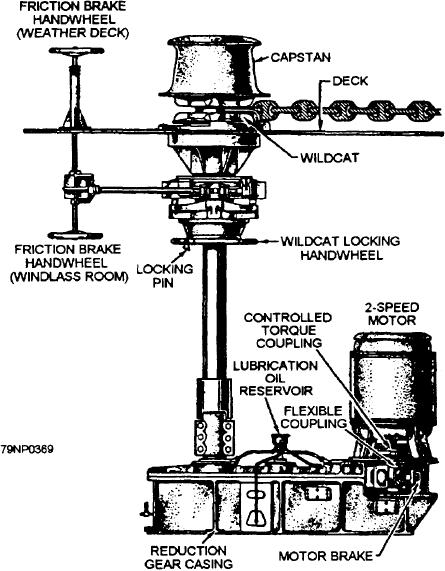
Figure 5-21.--Anchor windlass.
revolve. In this case, if the chain is engaged in the
shaft by a locking head located below the weather deck.
whelps on the wildcat, the chain should be free to run.
You can run the capstan independently for warping by
Be careful to select the proper direction of rotation and
disconnecting the locking head and holding the wildcat
be sure that the windlass is properly lubricated.
by the brake band on the brake drum. You can pin the
handwheel in the LOCKED or UNLOCKED positions.
You can operate the motor from either master switch
Ensure it is always fully locked or fully unlocked to
No. 1 (on the weather deck) or from master switch No.
prevent unnecessary wear on the brake.
2 (in the windlass room). Master switch No. 1
predominates. When the associated on-off switch
There is a hand brake on the wildcat shaft to control
located on master switch No. 1 is operated in the ON
the anchor handling. It is designed to operate in either
position, master switch No. 1 takes over the control from
direction of rotation of the wildcat and to stop and hold
master switch No. 2 (if both switches are operated
the anchor when dropped into a depth of 45 to 60
simultaneously).
fathoms. The brake is operated by a handwheel located
on the weather deck or by a duplicate handwheel in the
The anchor windlass is used alternately to handle
windlass room.
either the starboard or the port anchors. The windlass
is operated by a reversible motor in either of two
OPERATION.-- The windlass is operated by a
directions. These directions may be hoist for the
drum master switch on the weather deck and a duplicate
switch in the windlass room. It is important to
starboard anchor (lower for the port anchor) and hoist
for the port anchor (lower for the starboard anchor).
remember that if the windlass is run with the locking
However, only one anchor can be handled at a time.
handwheel in the LOCKED position, the wildcat will
5-35

